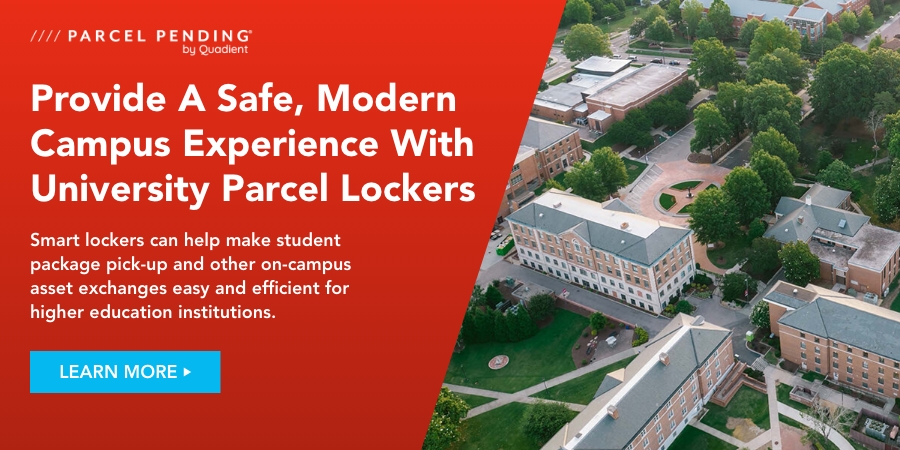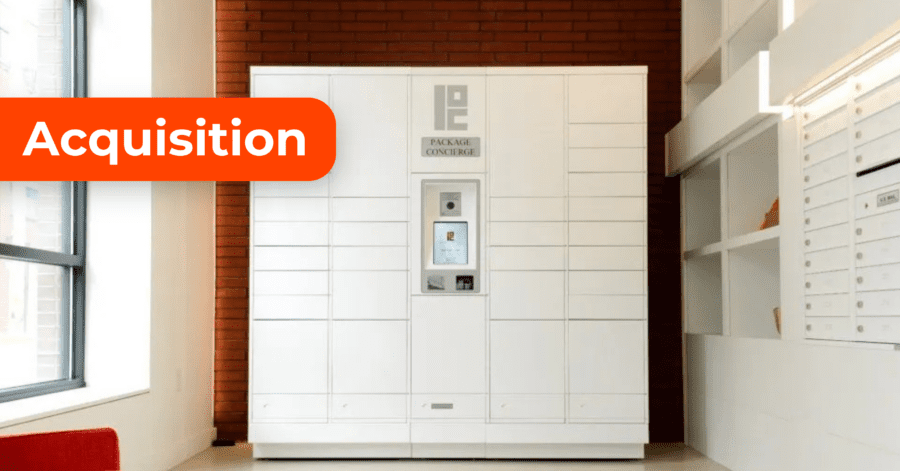
University
Online Shopping Trends On College Campuses
Written by: Parcel Pending
6 Min Read
Published: October 12, 2020
Updated: February 4, 2024
Online shopping is booming like never before. In fact, Forrester predicts that online retail sales will grow 18.5% this year, the fastest growth since 2008. And by 2024, Forrester predicts that over a quarter of all retail sales will take place online1.
Today’s college students are some of the key players in the online shopping boom. A whopping 96% have a smartphone and they spend more time on their phones than any other age group2.These Gen Z and millennial-aged young adults purchase everything from textbooks to food and groceries, clothing, electronics, dorm room supplies and more online and via their mobile devices.
Prior to COVID-19, college students were among the largest groups of online and mobile shoppers, and many schools were struggling to manage huge spikes in packages and deliveries on campus. The pandemic has only exacerbated this growing package problem.
With college students doing more of their shopping online, many higher education institutions are having to deal with holiday-like package volume year-round. However, many campus mail services centers at instructional facilities were not designed for such high package volume.
By examining college student consumer trends as they relate to online shopping, colleges and universities can learn how to better manage high package volumes and provide a premium student experience while also saving valuable staff time and money.
Social Media Influences the Shopping Behaviors of Colleges Students
College students – a mix of Gen Z and millennials – tout a whopping $143 billion buying power and make up about 40% of all consumers3. These younger generations are digitally connected, so it should come as no surprise that one of the biggest drivers of their shopping behavior is social media.
In fact, a recent study reported that 90% of college students are on Instagram, 80% are on Snapchat and half are on TikTok, and 50% of college students have made a purchase through Instagram4. Additionally, 93% of people ages 18-24 use YouTube at least once a week, and a majority of those use it more than once a day5. Most e-commerce marketers target college students with marketing, advertising and branding via these social media and streaming platforms.
Overall, social media plays a major role in influencing the shopping behaviors of college students – more so than other generations. Universities should be prepared for a continuous influx of packages and deliveries throughout the remainder of the year and into 2021 as more of today’s college students shop online and via their mobile devices.
Online Grocery Shopping is Booming
Online grocery shopping among today’s college students has been gaining in popularity due to the pandemic. Prior to COVID-19, only about 4% of grocery spending in the U.S. was online. Now, it has surged to 10% to 15%6.
College students are buying a larger volume of groceries online and ordering more frequently. In fact, a new survey revealed that 62% of Americans said they were grocery shopping online because of COVID-19. That same report also predicts that by 2025, online grocery shopping will reach $250 billion and account for 21.5% of all grocery sales. Just last month, U.S. grocery delivery and pickup sales totaled USD 5.7 billion (with peak sales at $7.2 billion in June)7,8.
With many colleges students having to self-quarantine for 14 days upon arrival to campus or after positive cases have been identified, we expect that online grocery shopping among college students will continue to rise.
COVID-19 is Driving Online Purchases
According to an ecampus.com study, students spend an average of $60 billion a year online on everyday items9.
Additionally, Adobe noted that the first seven months of 2020 saw $434.5 billion in e-commerce spending, which is $93.9 billion ahead of January forecasts for the year. If the e-commerce growth continues, 2020 would exceed all online spending for 2019 by October 510.
“So far this year, Parcel Pending has experienced a 73% year-over-year increase in package delivery volume,” stated Lori Torres, CEO and Founder of Parcel Pending by Quadient. “We expect this growth to continue, compounding on an even greater increase in package volume as we approach the 2020 holiday season.”
Package volume was already at a record high prior to COVID-19; now, the pandemic is intensifying campus package problems even further.
Smart Lockers to the Rescue
It’s not too late for colleges and universities to prepare for year-round, holiday-like package volume. One quick and easy way to do so is by investing in smart lockers.
Smart lockers eliminate the chaos of on-campus mail delivery and package management by assuming all of the customer service responsibilities for mail and parcel delivery, notification, and retrieval. In fact, up to 80% of online orders and packages, including grocery, medicine, and more, can be delivered directly to parcel lockers, freeing up campus mail services staff to focus on other tasks. Parcel Pending by Quadient university locker solutions also can reduce the labor resources demanded by package management by as much as a third.
With package lockers, university mail services no longer need to worry about crowded mail services lines or students rushing to collect their packages before the mail services center closes. Electronic lockers make it quick, easy, and convenient for students to retrieve their packages at their convenience, simplifying the package delivery process for university staff, students, and couriers alike.
And because students are able to pick-up their packages any time of the day without having to tie up mail services staff, campus mail operations will also experience fewer inquiries and complaints from students trying to locate their lost or stolen packages.
Contact-free Package Pick-up
Online shopping has increased in light of COVID-19 and so too has consumer behavior and approval of contact-free package pick-up. In fact, 87% of consumers want a contact-free option when it comes to retrieving their packages and online orders11.
Smart lockers provide seamless package management for campus mail services staff and a contact-free way for students, faculty and teachers to obtain deliveries at their convenience. With Parcel Pending by Quadient smart lockers, students can use their mobile device to open their corresponding locker door, thereby avoiding any contact with keypads, touchscreens, or package locker doors.
Package locker solutions can also help educational institutions adhere to state and local health guidelines by reducing contact with delivery drivers and couriers, thereby encouraging the safety of students and campus mail services staff. Instead of the numerous face-to-face interactions between delivery drivers and mail services staff, and then mail services staff and students, students are instead able to retrieve their packages from a self-service solution at any time of the day.
Self-service lockers can be made available 24/7, which helps eliminate the need for students to congregate in lines and encourage social-distancing in communal spaces. Campus mail services staff can then discourage drop-in traffic, asking students to make an appointment for any in-person questions or assistance.
Universities should invest in tech-forward solutions like smart parcel lockers to manage the daily influx of student packages and deliveries. Smart lockers solve a number of pain points for university mailroom operations including saving valuable staff time, diminishing lost or stolen packages, reducing operating costs, and providing an enhanced student experience.
As the market leader, we’ve helped thousands of leading colleges and universities preserve their reputation and bottom line with contact-free intelligent parcel locker solutions. Let us take care of the packages so you can take care of your prospective students, current students and staff.
Discover how our university package lockers take care of your packages so you can take care of your students and staff.
Sources:
- Chain Store Age. Available at: https://chainstoreage.com/forrester-more-25-all-retail-sales-will-take-place-online-2024
- Pew Research, “Mobile Fact Sheet.”. Available at https://www.pewresearch.org/internet/fact-sheet/mobile/
- The Power of Gen Z Influence. Available at http://www.millennialmarketing.com/wp-content/uploads/2018/01/Barkley_WP_GenZMarketSpend_Final.pdf
- National Retail Federation, “Social media drives Gen Z shopping behavior.” Available at https://nrf.com/blog/social-media-drives-gen-z-shopping-behavior
- Next Generation Engagement. Available at https://www.ryan-jenkins.com/wp-content/uploads/2018/01/Next-Gen-Engagement-CAPTURE-HIGHER-ED.pdf
- CNBC “As coronavirus pandemic pushes more grocery shoppers online, stores struggle to keep up with demand.” Available at: https://www.cnbc.com/2020/05/01/as-coronavirus-pushes-more-grocery-shoppers-online-stores-struggle-with-demand.html
- Spoon University “Study: Online Grocery to Hit $250B, Account for 21.5 Percent of Total Grocery Sales.” Available at https://thespoon.tech/study-online-grocery-to-hit-250b-account-for-21-5-percent-of-total-grocery-sales/
- Spendmenot. Available at https://spendmenot.com/blog/grocery-shopping-statistics/#:~:text=5.,do%20their%20grocery%20shopping%20ONLINE.&text=That’s%20certainly%20one%20way%20to,some%20of%20their%20groceries%20online
- E-Campus. Available at: http://images.ecampus.com/images/new-ecampus/infographic-where-is-the-money.jpg
- Adobe: E-commerce growth slows as stores reopen. Available at https://www.axios.com/adobe-e-commerce-growth-sales-covid-retail-2f53a126-b1fb-44db-91f9-5461a4ce58ca.html
- Shekel. (2020, April 7). 87% of Shoppers Prefer to Shop in Stores With Touchless or Robust Self-Checkout Options During COVID-19 Pandemic [Press release]. Retrieved from: https://www.businesswire.com/portal/site/home/news/




